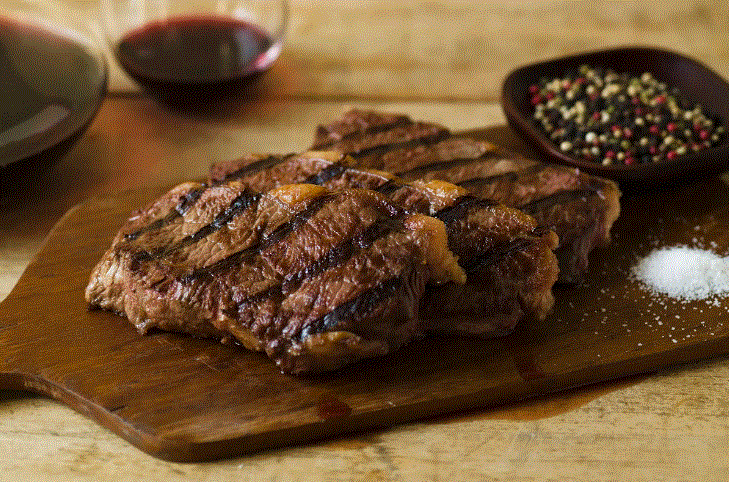Beef prices are poised to surge as a severe drought across the western US forces mass cattle slaughter — and meat distributors say the natural disaster could keep supplies tight for years.
From supermarkets to swanky steakhouses, purveyors warn that consumers could be faced with painful price increases — especially on prime meat — as soon as this month.
“We don’t know where prices could end up but it’s possible that they go back up to 2020 levels,” said Victor Colello, director of meat for the Morton Williams grocery chain in New York City.
That’s when COVID-19 outbreaks forced shutdowns at meat processing plants nationwide, tightening supplies even as locked-down consumers clamored for beef. In 2020, the grocer was selling rib meat for about $12 a pound compared to just under $9 currently. Filet mignon had soared to $18 per pound compared to $14 now, according to Colello.
Currently, meat prices are well above pre-pandemic levels in 2019, when rib meat cost $6 per pound and filet mignon was $9 per pound, he added. In June, ground chuck cost $5 per pound — not far off the high of $5.33 it hit in June 2020, according to the US Bureau of Labor Statistics.
“We haven’t seen any increases yet, but if the drought continues over the next few weeks, our vendors are telling us prices will go up,” said Joe Parisi, president of the Gristedes and D’Agostinos supermarkets in New York City.
Steakhouses are bracing for the worst. Veteran restaurateur Charlie Palmer, who operates 16 restaurants including five steakhouses, said he expects to hike prices on prime cuts by about 5% to 10% through the end of the year. A $56 filet mignon could cost as much as $61 and a $72 ribeye could go up to $79.
In response, the acclaimed chef is already replacing some of the high-end steaks on his menus with “secondary cuts” like top sirloin, flatiron steaks and so-called lifter meat, which comes from thin muscle around the shoulders.
“We are going to see steaks on menus that people have never heard of,” Palmer told The Post.
Uncle Jack’s Steakhouse, meanwhile, is weighing whether to increase its $25 burgers and steak sandwiches to $28 or $29, owner Willie Degel told The Post. That’s after the Midtown Manhattan meat emporium added burgers and steak sandwiches to the dinner menu during the pandemic to give diners lower-cost options.
The problem is that ranchers can’t sustain all the cows and steers in their herds as grasslands have dried up amid the worst drought conditions in a decade. In June, 2,000 cattle in Kansas dropped dead from heat stress.
In response, ranchers have been forced to sell their animals early, thinning the numbers of older cows. By some estimates, US beef-producing cattle herds could be slashed by up to 20% if the ranching industry gets rid of its older, calf-producing cows.
“The implications of fewer cows giving birth to calves are that over the next few years there will be higher beef prices,” said Peter Bozzo, vice president of Chef’s Warehouse, a food purveyor to high-end restaurants.
Nebraska rancher Brenda Masek said she was forced to cull her older cows in April — the first time she has done so in a decade. Her Nebraska ranch, Bestol & Masek, had little snow or rain over the winter.
“Everyone is looking at their grass,” said Masek, who is also president of the Nebraska Cattlemen Association. “We are still going to get consumers beef. But we will see higher prices especially with the better cuts.”
It takes 24 months to raise an animal for beef, and the early slaughters are shrinking supplies of prime-grade beef in particular. In the last months of the cows’ life cycle, they are fed a richer diet of grains, which develops into prime meat.
The cost to feed cattle has been boosted by the war in Ukraine, which produces 40% of the world’s grain. A bushel of corn costs $1.25 more than it did last year — or about $7 — and about $3 more than in 2019, according to industry data.
“We are facing a 40% increase in wholesale prices” for beef, Kevin Lindgren, Baldor’s director of meat, seafood and poultry, told The Post. “Consumers will go from a filet mignon to an 8-ounce burger. And we already seeing that shift.”
The upscale vendor to restaurants and gourmet food markets is paying about $8 per pound for New York strip and porterhouse steaks and expects to fork over as much as $16 per pound in 2023, Lindgren said.
“If herds are brought down to significantly lower levels, there could be beef inflation across the board,” said Daniel Romanoff, president of Bronx-based meat wholesaler Nebraskaland.













